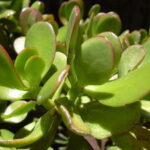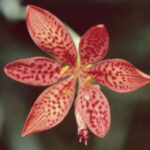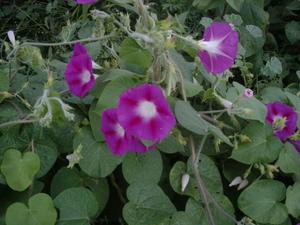The dwarf jade plant, also known as elephant’s food, elephant brush, elephant grass or money tree, is a native plant to South Africa. It is a member of the Portulacaceae family and is a good plant for someone new to growing plants or houseplants. Dwarf Jade plants are hardy in U.S. Department of Agriculture zones 10 through 11. In zones lower than 10, people grow this plant indoors as a houseplant.
Take Cuttings
You can start this plant from cuttings. The best time to propagate this plant is early spring to midsummer. Cut a stem with a sharp knife or a razor blade. You will want to take a cutting that is 2 to 3 inches long. Dip the cut end of the stem in rooting hormone. Lay the stem down on a sheet of paper and leave it for several days. A scab needs to form over the cut area before you can plant it. The length of time it takes for the end to callous over will vary. It really depends on the humidity in the air and the thickness of the stem.
Moisten the Soil
When the stem has calloused over, moisten some seed starting soil. You can put the soil on your worktable or a bucket. Fill a watering can and sprinkle a little water over the soil. With your hands, mix the soil until it is moisten. You can tell if you have added enough water by grabbing a handful of soil. Squeeze the soil in your hand. If the soil holds together without falling apart, you’ve added enough water. You don’t want to add so much water that you can squeeze water out of the soil either.
Place a coffee filter or small rocks over drainage holes in a 4-inch pot. Fill the pot with moistened soil until it is a 1/4 to ½ inch below the pot’s rim.
Planting the Stem
Push the stem in the soil so it is 1 to 2 inches deep. Firm the soil around the stem with your fingers to hold the stem upright. You can put the pot in a saucer to catch the water, or if you have started several cuttings, find an old cake pan to hold the pots. Find a warm sunny window to place your pots, but keep them 2 to 3 inches from the windowpane. A south or west-facing window is best for your plant. Do not water the cutting for approximately 3 weeks.
Check the Cutting
During that time, check the cutting occasionally. If it starts turning black, then that may be rotting. Carefully remove the cutting carefully to check for roots. Healthy roots will look white in color. If the stem is mushy, then the cutting has rotted and you will need to take another cutting.
Continue to grow the plant in the same location. When the plant is established, you can take it outside. The air temperature has to remain above 50 degrees Fahrenheit. Set the pot in a sunny location
Water the soil when it feels dry. Just like a cactus, they do not need a soil that stays evenly moist. Too much water and the plant will rot.
After-Care
The leaves on a dwarf jade can become dusty. When this happens, give the plant a bath. If the plant is outside, you can gentle spray the leaves with your water hose. Don’t spray too hard or you will damage the plant. If the jade plant is growing inside, you can place it in your shower. Before you spray it with the shower, adjust the water temperature. You don’t want the water to be too cold or hot. The water should feel tepid.
In the spring, fertilize the dwarf jade with a 10-10-10 slow release fertilizer. Always mix and apply according to label directions.
Every two to three years, you can repot the dwarf jade. If it is outgrown the pot, transplant in a pot that is 1 or 2 inches wider than the current pot. When you transplant, always wait until the soil is dry.
Resist watering again after repotting until you see new growth. Put the plant in a semi-shaded location until new growth appears. Then you can move it to a brighter location.
As the plant grows, remove any dead leaves or branches. Watch for pests like mealy bugs and aphids. If you notice any during warm weather and the plant is outside, wash them away using the gently spray on the garden hose. If the plant is indoors, wash the plant off in the shower. You can also soak a cotton ball in rubbing alcohol and wipe the leaves and stems to remove the pests. This method also removes scale. Pesticides may be used, but make sure you choose one that does not have a petroleum base, otherwise you risk killing your plant.
Sources:
North Dakota State University: Questions on Jade Plants; Ron Smith
“The Houseplant Expert”; Dr. D.G. Hessayon
“The Houseplant Encyclopedia”; Maggie Stuckey





